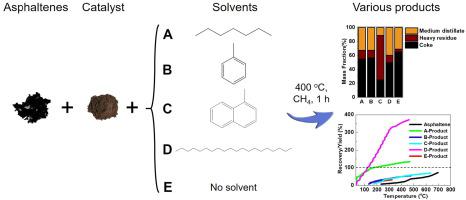Fuel ( IF 6.7 ) Pub Date : 2021-02-02 , DOI: 10.1016/j.fuel.2021.120157 Hao Xu , Zhaofei Li , Yimeng Li , Hua Song

|
Asphaltenes are widely existing in crude oils, which are generally the heaviest and most intractable components with low value. However, it has been proved in our previous study that catalytic heavy oil upgrading process under methane environment can effectively convert asphaltenes into light fractions, leading to remarkable improvement of oil qualities such as decreased TAN, sulfur content and higher yield of light fractions. In this work, asphaltenes were extracted and upgraded under methane environment using several typical paraffinic and aromatic oil components as the solvents. It was found that the presence of solvent facilitates the mixing of catalyst and asphaltenes, reducing coke formation and enhancing the yields of light products. Specifically, paraffins such as heptane and eicosane lead to slightly decreased asphaltene conversion but much higher light fraction yield, which can be attributed to the formation of small hydrocarbon radicals through cracking of the paraffinic chain. Although aromatic solvents such as toluene and 1-methylnaphthalene have little interaction with asphaltenes in terms of chemical reactions during the upgrading process, heavier aromatic components such as 1-methylnaphthalene demonstrate noticeable solvent effect, which successfully prevent the excessive polymerization of asphaltenes towards coke formation by improving the dispersion of asphaltenes. It is suggested that this solvent effect is closely related to phase behavior, which is determined by whether the solvent remains in liquid phase under given reaction conditions. On the other side, the presence of asphaltenes generally lowers the conversions of methane and solvents by partially covering the catalytic surface. For paraffinic solvents, asphaltenes also reduce the selectivity of converted solvent molecules towards aromatics by blocking internal pores of catalysts. In summary, the interaction between solvent molecules and asphaltenes is essential for successful asphaltene conversion to desirable products in heavy oil upgrading processes.
中文翻译:

甲烷环境下催化沥青质的提质:溶剂效应及其与含油组分的相互作用
沥青广泛存在于原油中,通常是最重,最难处理的成分,价值低。但是,在我们以前的研究中已经证明,甲烷环境下的催化重油提质工艺可以有效地将沥青质转化为轻质馏分,从而显着改善了油质,例如降低了TAN,硫含量和提高了轻质馏分的收率。在这项工作中,使用几种典型的链烷烃和芳族油成分作为溶剂,在甲烷环境下提取并提质了沥青质。发现溶剂的存在促进了催化剂和沥青质的混合,减少了焦炭的形成并提高了轻质产品的产率。特别,石蜡(如庚烷和二十烷)可导致沥青质转化率略有下降,但轻馏分收率高得多,这可归因于通过链烷烃链的裂解形成小的烃基。尽管在升级过程中,芳族溶剂(例如甲苯和1-甲基萘)与沥青质之间的化学反应几乎没有相互作用,但较重的芳族组分(例如1-甲基萘)表现出明显的溶剂作用,从而成功地防止了沥青质过度聚合而形成焦炭。改善沥青质的分散性。建议该溶剂效应与相行为密切相关,这取决于溶剂在给定的反应条件下是否保留在液相中。另一方面,沥青质的存在通常通过部分覆盖催化表面来降低甲烷和溶剂的转化率。对于链烷烃溶剂,沥青质还可以通过堵塞催化剂的内部孔来降低转化的溶剂分子对芳烃的选择性。总之,在重油提质工艺中,溶剂分子与沥青质之间的相互作用对于将沥青质成功转化为所需产品至关重要。













































 京公网安备 11010802027423号
京公网安备 11010802027423号